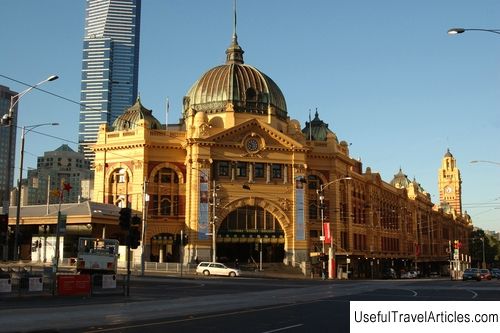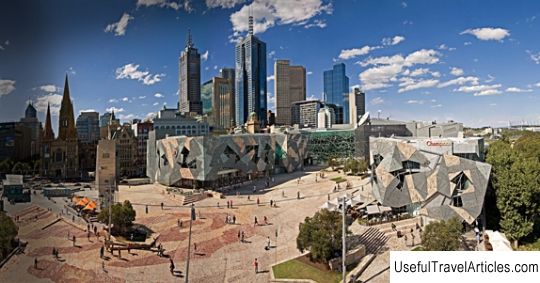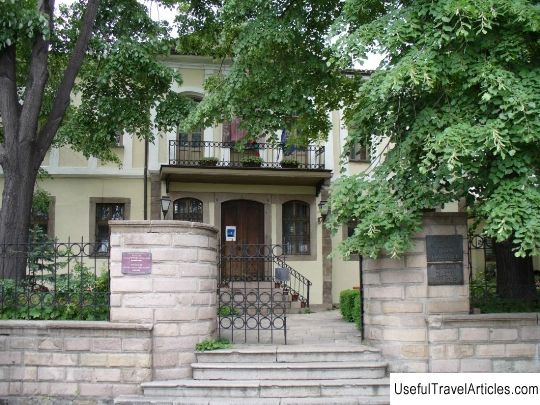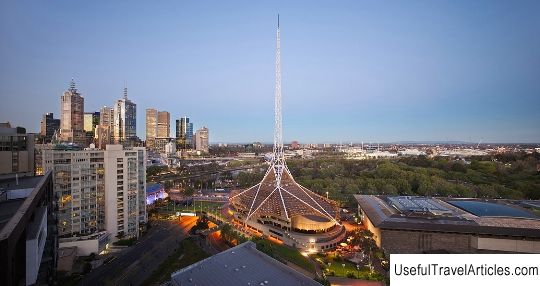Flinders Street Station description and photos - Australia: Melbourne
Flinders Street Station description and photos - Australia: Melbourne. Detailed information about the attraction. Description, photographs and a map showing the nearest significant objects. The name in English is Flinders Street Station. Photo and descriptionFlinders Street Station is the main railway station in Melbourne, located in the city center and is its kind of business card. Every weekday, 1,500 trains pass through this station, carrying more than 110 thousand passengers. But the station is also a popular meeting place for citizens. They say that the inhabitants of Melbourne use the expression "meet under the clock", which means meeting at the main entrance to the station building, over which a clock hangs. And the phrase "meet on the stairs" means a rendezvous at the steps of the main entrance to the station building. And it is this building that is most often depicted on ceremonial postcards in Melbourne. In 1854, the first railway station of the city, which was called “Melbourne”, was located here. That wooden terminal was Australia's first train station, and on the opening day, the country's first steam locomotive departed. Already in 1882 it was decided to build a new station - a competition was announced for the best project, in which 17 architects took part. But construction work began only in 1900 and was completed in 1910. Interestingly, the project of the Flinders Street station was later taken as the basis for the Loose Station in the Brazilian city of San Paolo. The first electric train left the station in 1919, and just 7 years later, Flinders Street was already the busiest train station in the world! In the second half of the 20th century, the famous clock on the main facade of the building, acquired in England in the 1860s, was replaced with digital ones, but the public demanded that the historical landmark be returned to its place - and the clock again took its place. In the 1970s, the state government was going to demolish the station building, because by that time it had fallen into disrepair. It was planned to build office buildings in its place. And again the public intervened - numerous campaigns to protect the architectural monument led to the government abandoning its plans and even allocating money for repairs. Restoration work began in 1984 at a cost to the state of A $ 7 million. With this money, the platforms were repaired and improved, a new restaurant was opened, and the staircase of the main entrance was equipped with electric heating to keep it dry in any weather. In the 1970s, the state government was going to dismantle the station building, as by that time it had fallen into disrepair. It was planned to build office buildings in its place. And again the public intervened - numerous campaigns in defense of the architectural monument led to the government abandoning its plans and even allocating money for repairs. Restoration work began in 1984 at a cost to the state of A $ 7 million. With this money, the platforms were repaired and improved, a new restaurant was opened, and the staircase of the main entrance was equipped with electric heating to keep it dry in any weather. In the 1970s, the state government was going to dismantle the station building, as by that time it had fallen into disrepair. It was planned to build office buildings in its place. And again the public intervened - numerous campaigns in defense of the architectural monument led to the government abandoning its plans and even allocating money for repairs. Restoration work began in 1984 at a cost to the state of A $ 7 million. With this money, platforms were repaired and improved, a new restaurant was opened, and the staircase of the main entrance was equipped with electric heating to keep it dry in any weather. And again the public intervened - numerous campaigns in defense of the architectural monument led to the government abandoning its plans and even allocating money for repairs. Restoration work began in 1984 at a cost to the state of A $ 7 million. With this money, the platforms were repaired and improved, a new restaurant was opened, and the staircase of the main entrance was equipped with electric heating to keep it dry in any weather. And again the public intervened - numerous campaigns to protect the architectural monument led to the government abandoning its plans and even allocating money for repairs. Restoration work began in 1984 at a cost to the state of A $ 7 million. With this money, the platforms were repaired and improved, a new restaurant was opened, and the staircase of the main entrance was equipped with electric heating to keep it dry in any weather. so that it stays dry in any weather. so that it stays dry in any weather.    We also recommend reading Casa Calvet description and photos - Spain: Barcelona Topic: Flinders Street Station description and photos - Australia: Melbourne. |





